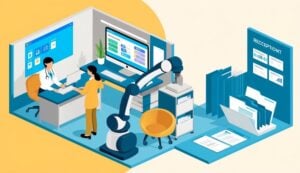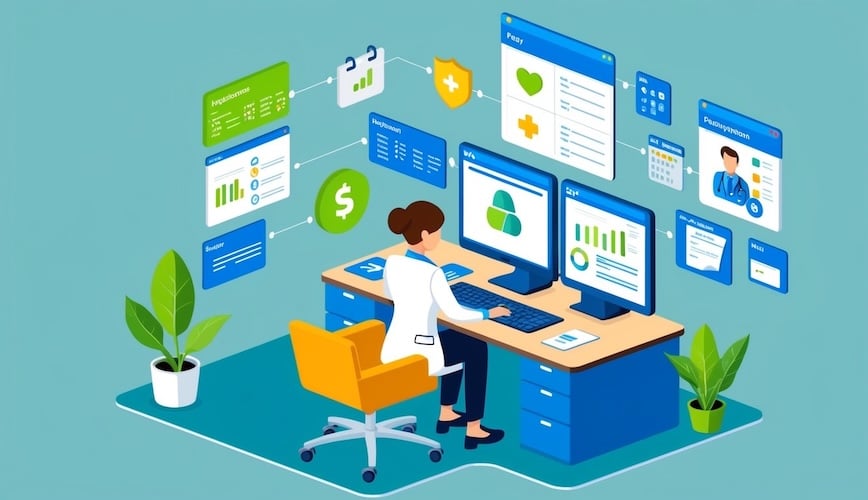Let’s be honest—when most people hear “healthcare administration,” their eyes glaze over faster than you can say “patient intake forms.” But for those in the trenches, it’s a thrilling mix of juggling data, navigating regulations, and trying to keep the chaos organized. And if you’re someone who finds excitement in optimizing workflows and ensuring compliance, you know exactly what I mean!
Now, imagine adding some AI-powered automation into the mix—it’s like upgrading from a clunky old pager to the latest smartphone. Suddenly, the mundane becomes not only manageable but genuinely exciting. Stick around as we explore how automating healthcare administration can make your day-to-day not just easier, but dare I say—fun.
Key Takeaways:
- Automation in healthcare administration reduces operational inefficiencies: By implementing automation in healthcare administration, organizations can slash manual labor costs and boost operational accuracy, resulting in significant cost savings and faster administrative processing.
- AI-driven tools enhance compliance and data security: Through healthcare administrators automation, compliance with ever-evolving regulations is simplified, and data security is strengthened, reducing the likelihood of costly mistakes and breaches.
- Strategic automation improves both staff retention and patient satisfaction: Implementing automation healthcare administration relieves staff from monotonous tasks, leading to higher job satisfaction, reduced burnout, and, in turn, more attentive patient care.
Table of Contents:
- The Current State of Healthcare Administration
- Healthcare Administration: A Prime Candidate for Automation
- Automation in Healthcare Administration: Technologies and Solutions
- Key Benefits of Automating Healthcare Administration
- Overcoming Implementation Challenges
- Measuring Success: KPIs for Healthcare Administration Automation
- Future Trends in Healthcare Administration Automation
- How Topflight Automates Healthcare Administration—So Humans Can Get Back to Care
- Ready for Admin Tasks Automation?
The Current State of Healthcare Administration
It’s quite eye-opening to realize that administrative costs constitute nearly 25% of total healthcare expenditures in the United States, as reported by the American Medical Association in 2023. This figure underscores the hefty financial toll that inefficient administrative processes can impose.
As healthcare entities work tirelessly to provide quality patient care, the imperative to streamline administrative tasks through automation becomes glaringly obvious. Tackling these inefficiencies is not just a matter of trimming costs; it’s about boosting operational effectiveness and paving the way for a more robust healthcare delivery system.

Manual Processes and Their Impact
Healthcare administration has long been a labyrinth of manual processes that drain valuable resources and time. Despite the advances in technology, many healthcare organizations remain bogged down by outdated methodologies, which can significantly impede operational efficiency. The impact on healthcare management is profound:
- Inefficiency and Errors: Manual data entry and paperwork often lead to errors that can disrupt clinical workflow automation and patient care. This inefficiency is a concern for 85% of healthcare executives who feel that AI adoption is progressing too slowly, according to the EY AI Anxiety in Business Survey.
- Resource Drain: Staff spend countless hours on administrative tasks that could be better allocated to direct patient care activities. With 31% of healthcare professionals now regularly using AI (as per McKinsey’s 2024 Global Survey), nearly double from the previous year, there’s a growing recognition of the need for transformation.
- Delayed Decision-Making: Slow information processing impacts the timeliness of decisions critical to healthcare delivery and management.
Transforming these manual processes is essential to improve efficiency and reduce errors in health systems.
The Rising Costs of Administrative Inefficiency
The financial burden of administrative inefficiency is escalating. According to recent studies, administrative costs account for a significant portion of healthcare expenditures. This financial strain is exacerbated by:
- High Labor Costs: Dependence on human resources for routine tasks inflates operational budgets.
- Redundant Processes: Overlapping and redundant administrative processes lead to unnecessary expenditure.
- Revenue Leakage: Errors in billing and claims processing due to manual handling result in revenue loss.
By implementing automation healthcare administration solutions, healthcare organizations can transform these challenges into opportunities for cost savings. AI and machine learning are projected to save the healthcare industry up to $360 billion, highlighting the financial potential of automation. Automation not only cuts down on wasted resources but also enhances accuracy, ensuring that the revenue cycle is optimized.
Regulatory Compliance Challenges
Navigating the complex landscape of regulations presents another layer of difficulty for healthcare administrators. Compliance is not just about meeting legal requirements; it’s also about protecting patient data and maintaining trust. Key challenges include:
- Evolving Regulations: Keeping up with constantly changing laws and standards is a daunting task for any healthcare management team. The lack of readiness in existing technology platforms is often cited as a major obstacle by executives.
- Data Security: Ensuring the confidentiality and security of patient information amidst increasing cyber threats is critical.
- Audit Readiness: The need for meticulous documentation to satisfy regulatory audits demands a high level of precision in administrative tasks.
Automation offers a robust solution here. By integrating clinical workflow automation, healthcare organizations can ensure compliance is maintained efficiently, reducing the risk of non-compliance penalties and enhancing data security.
Healthcare Administration: A Prime Candidate for Automation
With nearly 90% of healthcare executives prioritizing digital and AI transformation, the push for automation in healthcare administration is more urgent than ever. This evolution allows healthcare providers to streamline processes and significantly reduce administrative burdens, ultimately boosting efficiency and patient care.
Administrative Tasks Ripe for Automation
Healthcare administration is saturated with tasks that are repetitive yet crucial for operational success. These tasks are not just time-consuming but also prone to human error, making them perfect for automation:
- Claims Processing: Automating claims processing can significantly reduce the time it takes to review and approve insurance claims, ensuring faster reimbursement cycles and reducing the chance of errors.
- Appointment Scheduling: Automated systems can handle appointment scheduling efficiently, minimizing double bookings and maximizing the utilization of healthcare providers’ time.
- Medical Records Management: Automation can enhance the accuracy and accessibility of medical records, ensuring that providers have the information they need at their fingertips without the administrative burdens of manual data entry.
After budget constraints, legacy systems are identified as the second biggest hurdle to successful digital and AI transformation over the next two years, according to the McKinsey Digital and Analytics Provider Survey.
- Billing and Invoicing: Automating billing processes ensures accurate and timely payments, reducing the risk of errors and delays.
- Patient Communication: Automated reminders and follow-ups enhance patient engagement and reduce no-show rates.
- Inventory Management: Streamlining the tracking and ordering of medical supplies helps maintain optimal stock levels and minimize wastage.
- Credentialing: Automating the verification of healthcare providers’ credentials ensures compliance and accelerates onboarding.
- Reporting and Analytics: Automated generation of reports facilitates data-driven decision-making and performance monitoring.
By addressing these and other admin tasks through automation in healthcare administration, organizations can streamline workflows, reduce costs, and improve patient satisfaction.
Read more on automated insurance verifications to understand how frontline teams benefit from streamlined workflows.
The Role of AI in Modern Healthcare Management
Artificial Intelligence (AI) is revolutionizing healthcare management by providing intelligent solutions that learn and adapt over time. Its role in transforming administrative functions is particularly noteworthy:
- Predictive Analytics: AI can analyze vast amounts of data to predict trends and outcomes, enabling proactive decision-making and improving patient care strategies.
- Natural Language Processing: This technology allows for efficient data extraction from unstructured data sources, such as patient notes, thereby enhancing the quality of medical records.
- Intake Management Automation: AI-driven automation can streamline the patient intake process, reducing wait times and improving the overall patient experience.
These AI-driven capabilities not only enhance operational efficiency but also help in overcoming some of the most common objections related to data security and compliance, providing doctors with a robust framework for modernizing their practices.
Case Study: Successful Implementation Story
A recent project actively developed by Topflight showcases how AI can revolutionize healthcare administration by providing caregivers with real-time, hands-free access to essential patient data.
This HIPAA-compliant mobile chatbot utilizes generative AI and ChatGPT to deliver immediate, accurate information about patients, reducing human error and enhancing care quality. By automating tasks like medication scheduling and behavioral guidance, it exemplifies how similar AI-driven solutions can streamline administrative processes across healthcare settings, making it an ideal model for automating healthcare administration tasks.
Automation in Healthcare Administration: Technologies and Solutions
Advancements in technology have paved the way for transformative solutions in healthcare administration, offering an unprecedented opportunity for efficiency and innovation. By harnessing these technologies, healthcare organizations can address the myriad challenges they face in administration.
RPA in Healthcare Administrative Workflows
Robotic Process Automation (RPA) is revolutionizing how healthcare administrators handle routine tasks. By automating repetitive processes, RPA frees up valuable time for staff to focus on more strategic activities, enhancing productivity and reducing errors:
- Streamlining Processes: RPA can automate tasks such as patient data entry, appointment scheduling, and claims processing, ensuring consistency and accuracy.
- Reducing Human Error: By eliminating manual data handling, RPA minimizes mistakes, leading to more reliable outcomes and improved patient satisfaction.
- Cost Efficiency: Automation reduces the need for extensive manual labor, thereby cutting costs and improving resource allocation.
Generative AI and Machine Learning Applications
Artificial Intelligence (AI) and machine learning are key players in transforming healthcare administration by offering intelligent insights and streamlining complex processes:
- AI in Medical Billing and Coding: AI algorithms can quickly and accurately process billing codes, reducing errors and speeding up the reimbursement cycle.
- Predictive Analytics: Machine learning models can predict patient trends and outcomes, allowing healthcare providers to make informed decisions that improve care and operational efficiency.
- Enhanced Decision-Making: AI can analyze large datasets to provide actionable insights, helping healthcare leaders tackle challenges like resource allocation and patient flow management effectively.
Cloud-Based Administrative Platforms
The cloud is reshaping how healthcare organizations manage their administrative functions, providing scalable and secure solutions that support innovation:
- Seamless Integration: Cloud-based platforms facilitate the integration of new technologies with existing systems, ensuring healthcare administrators automation without disrupting operations.
- Data Accessibility: These platforms offer real-time access to data, enhancing collaboration and decision-making across departments.
- Scalability and Flexibility: Cloud solutions grow with the organization, accommodating increasing data volumes and evolving needs with ease.
At Topflight, we recognize that choosing the right technologies and solutions is crucial for successful digital transformation. Our expertise in healthcare app development ensures that our clients have access to cutting-edge tools tailored to their unique needs, empowering them to overcome the challenges of healthcare administration with confidence and agility.
Check out our healthcare app development services
Key Benefits of Automating Healthcare Administration
As healthcare administration continues to grapple with inefficiencies and cost burdens highlighted in previous sections, automation emerges as a pivotal solution, transforming administrative operations and addressing these challenges head-on with significant benefits.
Cost Reduction and ROI Analysis
- Operational Efficiency: Automation in health care administration significantly reduces overhead by streamlining processes that were previously manual and labor-intensive. This shift leads to a notable decrease in operational costs.
- ROI Calculations: By automating repetitive tasks such as billing and scheduling, healthcare organizations can achieve a quick return on investment. The reduction in human error and the subsequent need for rework further contributes to cost savings.
Improved Accuracy and Compliance
- Error Reduction: Automation minimizes the risk of human error, particularly in critical areas like medical record automation. This ensures that data is accurate, up-to-date, and easily accessible.
- Regulatory Compliance: Automated systems can be programmed to adhere to evolving regulations, ensuring compliance with minimal manual oversight. This enhances the organization’s ability to meet industry standards consistently.
Also read: HIPAA Compliant App Development Guide
Enhanced Staff Satisfaction and Retention
- Reduction in Burnout: By automating mundane and repetitive tasks, healthcare staff can focus on more engaging and meaningful work, thereby reducing burnout and enhancing job satisfaction.
- Improving Retention Rates: With a more satisfied workforce, healthcare organizations see improved staff retention rates. Staff members are more likely to remain with an organization that invests in technology to improve their daily workflow.
Additional Benefits
- Improved Patient Care: By freeing up administrative staff from time-consuming tasks, more resources can be allocated to patient-centric activities, improving overall care quality.
- Increased Efficiency: Automation enhances the efficiency of healthcare operations by reducing task completion times and increasing throughput without compromising accuracy or quality.
Overcoming Implementation Challenges
Implementing automation in health administration requires a strategic approach to effectively tackle potential challenges. While 75% of healthcare executives rank digital transformation as a top priority, a significant gap exists in planning and resource allocation necessary for successful execution, as noted by McKinsey.
This underscores the urgency of addressing critical areas such as data security, integration with existing systems, and comprehensive staff training. By focusing on these elements, healthcare organizations can navigate the complexities of automation and overcome barriers to transformation.
Ensuring Data Security and Privacy
Data security is a paramount concern in healthcare practice automation, given the sensitive nature of patient information. Ensuring data integrity and privacy while implementing automation involves the following.
Comprehensive Security Protocols
Develop and enforce stringent data protection measures, including encryption and access controls, to safeguard patient information.
Compliance with Regulations
Ensure that all automation processes adhere to relevant regulations such as HIPAA, protecting both hospital and patient data integrity.
Regular Audits and Updates
Conduct regular security audits and update systems to protect against emerging threats, ensuring continuous security compliance.
Integration with Existing Systems
Seamless integration of automation solutions into current systems is crucial for maximizing benefits without disrupting operations:
- Interoperable Solutions: Choose automation tools designed for compatibility with existing hospital information systems (HIS) to ensure smooth data flow and operational continuity.
- Phased Implementation: Gradually introduce automation technologies, allowing time for testing and adjustments without overwhelming the system or staff.
- Customizable Interfaces: Utilize solutions with customizable interfaces to match organizational workflows, enhancing usability and minimizing transition disruptions.
Also Read: How to Integrate your medical app with EHR
Staff Training and Adoption Strategies
Effective staff training and adoption strategies are critical to the success of practice automation. Comprehensive training programs should be developed to cover both the technical aspects of new systems and the strategic benefits they bring. This ensures that staff are not only equipped with the necessary skills but also understand the broader impact of automation on their workflows and patient care.
Implementing robust change management practices is essential to addressing potential resistance. By fostering a culture of innovation and adaptability, organizations can promote a positive attitude towards the transition. Continuous support and feedback mechanisms further reinforce successful adoption by providing staff with ongoing assistance and opportunities to voice their concerns and suggestions.
Measuring Success: KPIs for Healthcare Administration Automation
In the quest to automate healthcare administration, measuring success through key performance indicators is vital for healthcare organizations to gauge the effectiveness of their automation efforts. By focusing on operational efficiency, financial impact, and quality and compliance, healthcare CIOs can gain a comprehensive understanding of how automation is transforming their administrative processes.
Operational Efficiency Metrics
Operational efficiency is a cornerstone of successful healthcare administration. Automation aims to streamline processes, reduce errors, and improve system uptime. For instance, evaluating process cycle times pre- and post-automation provides insight into how efficiently tasks are accomplished. A notable decrease in error rates signifies improved accuracy and reliability of the automated systems. Additionally, assessing system uptime ensures uninterrupted service, which is crucial for maintaining the smooth operation of healthcare facilities. Consider these points:
- Process cycle times can reveal bottlenecks and areas needing improvement.
- Monitoring error rates helps in understanding the reliability of automated solutions.
Financial Impact Indicators
Financial performance is a critical area where automation can deliver substantial benefits. Automated medical billing is an excellent example, as it can significantly reduce billing errors and accelerate the billing cycle, leading to enhanced revenue capture and cost savings.
By comparing the labor costs before and after implementing automation, organizations can identify significant reductions in manual labor expenses. Calculating the ROI of automation investments by comparing the financial benefits realized against the costs incurred provides a clear picture of the value addition.
Learn more about healthcare revenue cycle automation and how it enhances compliance while driving operational efficiency.
Quality and Compliance Measurements
Quality and compliance are non-negotiable in the healthcare sector. Automation has the potential to elevate these standards. By ensuring compliance with regulatory standards, healthcare organizations can avoid costly fines and improve patient trust. Enhanced patient satisfaction scores often result from efficient administrative processes, as automation enables healthcare providers to focus more on patient care rather than paperwork. Key considerations include:
- Compliance tracking to meet healthcare regulations.
- Improved patient satisfaction scores reflecting enhanced service delivery.
- Better data accuracy supports informed decision-making.
Future Trends in Healthcare Administration Automation
As healthcare administration continues to evolve, the landscape is being reshaped by emerging technologies that promise to enhance efficiency and outcomes. Among these, advancements such as artificial intelligence, machine learning, and robotic process automation are driving the industry towards more streamlined operations.
These technologies are at the forefront, driving the industry towards more streamlined operations. The integration of predictive analytics in administration is particularly transformative, enabling healthcare organizations to:
- Anticipate needs
- Optimize resource allocation
- Improve decision-making processes
One area seeing significant innovation is dental office automation, which exemplifies how specific sectors within healthcare are adopting automation to improve patient care and operational efficiency. By leveraging advanced scheduling tools and automated patient communication systems, dental practices can reduce administrative burdens, allowing staff to focus more on patient interaction and less on paperwork.
The journey towards fully automated workflows is becoming increasingly tangible as these technologies mature. The prospect of end-to-end automation in healthcare administration not only offers the potential for substantial cost savings but also the ability to drastically reduce staff burnout by eliminating repetitive tasks.
How Topflight Automates Healthcare Administration—So Humans Can Get Back to Care
Paper pushing still devours 1-in-4 U.S. healthcare dollars—yet our clients prove that the right AI can chew through that backlog instead of your payroll. Take GaleAI: by tagging charges in seconds it slashed coding effort 97 % and pulled in up to 15 % more revenue for early adopters.
Or Mi-Life, the HIPAA-compliant voice chatbot that lets caregivers surface patient-specific data on demand, cutting medication errors and earning sky-high staff-satisfaction scores.
Layer in the $188 million+ raised by products we’ve engineered, and it’s clear investors trust numbers that shrink admin overhead.
Why operations teams choose Topflight
-
AI-first playbook – NLP, RAG, and rules engines spot gaps before they become denials or safety events.
-
Compliance from sprint one – HIPAA, SOC-2, and PHI-safe pipelines are baked in, so security never derails go-live.
-
Dashboards that speak CFO – Real-time metrics on recovered revenue, error rates, and staffing lift, pre-wired for board decks.
-
Weeks-not-months delivery – Cross-platform React stacks and cloud DevOps mean your pilot ships while rivals are still mapping workflows.
Ready for Admin Tasks Automation?
Topflight’s comprehensive AI consulting services are designed to tackle complex business challenges and innovate solutions that streamline processes, enhance patient care, and optimize operational efficiency.
With expertise in AI strategy development, custom solution design, and seamless integration, we are committed to transforming the healthcare landscape. Our projects, like AI-powered document processing and intelligent chatbots, showcase our dedication to improving both administrative workflows and patient outcomes.
As we continue to push the boundaries of innovation, Topflight remains focused on delivering tailored AI solutions that meet the unique needs of healthcare organizations. We invite you to connect with our experts to explore how we can support your goals in automating healthcare administration. Schedule a call with us today to discover how our cutting-edge technologies can elevate your organization’s efficiency and impact in the healthcare sector.
Frequently Asked Questions
What is healthcare administration automation?
Healthcare administration automation uses technology to streamline repetitive tasks, enhancing efficiency, reducing errors, and freeing up staff to focus on patient care.
Which administrative tasks can be automated in healthcare?
Tasks like appointment scheduling, claims processing, billing, medical records management, and patient communication can be effectively automated to improve operational efficiency.
How does automation improve data security in healthcare?
Automation enhances data security by minimizing human error, ensuring compliance with regulations, and employing advanced encryption technologies to protect sensitive patient information.
Can automation help reduce administrative costs in healthcare?
Yes, automation cuts costs by reducing manual workload, improving process efficiency, and minimizing errors, leading to significant savings for healthcare organizations.





